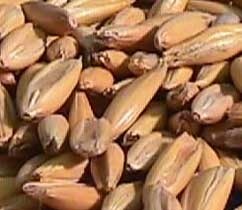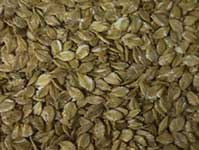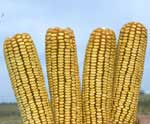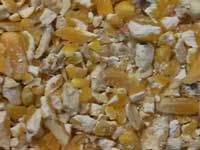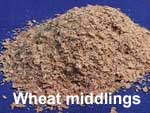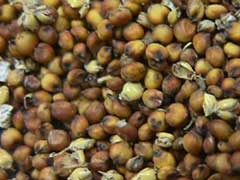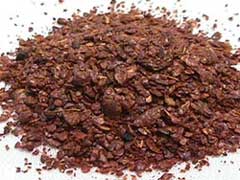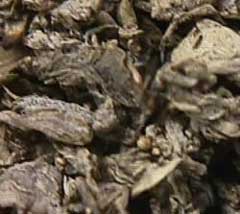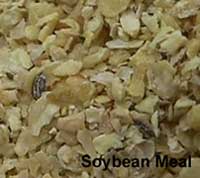The concentrate portion of the ration contains grains that are higher in energy and lower in fiber than roughages. Many grains are fed to horses. The most common are oats, barley, and corn. Wheat and milo are other grains fed to horses.
Oats
Oats are the most popular and safest grain to feed to horses. What makes oats a safe feed is the fiber content–about 13 percent. This means oats have more bulk per nutrient content, and horses have to eat more to satisfy their nutrient requirements. Bulk makes it more difficult for the horse to overeat and get colic or founder.
Kernels should be plump, heavy, and clean and have a bright color, clean smell, and a low ratio of husks to kernels. The heavier the oats, the more nutrient contained per unit of weight. U.S. No. 1 oats weigh 36 lb (16.3 kg) per bushel, whereas U.S. No. 4 oats weigh about 27 lb (12.2 kg) per bushel. Oats should be bought according to the least cost per unit of energy, provided they are clean and stored properly. Clean oats are important. Oats should be cleaned to remove dirt, weeds, other seeds, and broken kernels. Dust in oats indicates that the oats are old and may be of lesser quality. You can check to see if your oats are dusty by pouring them into a can and back into the sack. A musty smell indicates that the oats have been stored with too much moisture and will spoil. Oats should not have a sour or bitter taste.
Oats can be fed whole or processed. Processing includes crimping, rolling, or crushing the kernel. Whole oats are easily eaten and digested by the horse. If oats are processed, a slight crimp is sufficient. When the kernel coat is broken by processing, less chewing is required, and digestive juices have better access to the kernel.
Barley
Barley is very similar to oats as a feed except for some characteristics that affect how it is used. Barley is lower in fiber than oats and is classified as a “heavy” feed. Barley is more energy dense and weighs more per unit of volume (48 pounds per bushel, or 22 kg) than oats. The barley kernel is harder than the oat kernel, so it is usually rolled before feeding. If the barley kernel is crushed or ground, it is too heavy and can cause colic unless mixed with a bulkier feed such as wheat bran.
Corn
Corn is one of the most energy-dense feeds and contains a high content of carbohydrate. Corn has a high energy content per unit of weight and a high weight per unit volume. Therefore, a given volume of corn contains approximately three times the amount of energy as an equal volume of oats. Corn’s high energy content has led to it becoming known as “too hot” a feed for horses. However, if the horse is fed to meet its energy requirement, corn is an excellent feed.
Corn quality is judged by the moisture content and percentage of well-formed kernels. Very few damaged kernels should be present. In addition, kernels should be plump, firm, and separated. There should be no insect or mold damage. Moisture content should be less than 14 percent. The kernel is high in starch and readily fermentable; therefore, it can become toxic.
Corn can be fed in the following forms:
- On the cob – This form can be used as a management tool for horses that bolt (eat too fast) their grain. However, older horses or horses with bad teeth have difficulty eating whole corn. Whole corn will keep longer than shelled corn, but it is more costly to store.
- Shelled whole corn – Some whole-corn kernels will pass through the digestive tract without being digested. Therefore, it is advisable to process the kernels in some way to increase digestion.
- Cracked corn – Cracking the corn kernel may be preferred because it allows digestive juices to enter the corn and increase digestibility.
- Steamed rolled corn – Steam rolling further processes the corn kernel, creating more surface area for digestive juices and increasing digestibility.
- Ground or crushed corn – This type of processing makes the corn kernel too small. If the corn passes through the small intestines too rapidly, it can lead to fermentation in the hind gut. This may lead to colic if the horse is being feed a high-concentrate diet. Whole-ear ground corn can be fed to horses because the cob is high in fiber and low in energy.
Wheat
Most wheat is used for human consumption, with little fed to horses. Wheat is fed to horses more in the Southwest and Northwest than other parts of the country. By-products of the milling process, such as wheat bran, are most commonly fed to horses. Wheat bran is the hard outer coating of the kernel. One popular way of feeding wheat bran is in the form of a mash. It is highly palatable and is frequently used to add bulk to a diet. It is also fed to increase phosphorus content. Wheat bran is 12 percent digestible protein. Wheat middlings are fine particles of the wheat kernel obtained during the milling process. If wheat middlings are fed to horses, they must be mixed with a bulky feed.
Milo (Grain Sorghum)
Milo is a high-energy grain fed to horses primarily in the southwestern United States. It is a very heavy feed and should be mixed with a bulky feed to prevent digestive disturbances. It needs to be cracked to make it easier for horses to chew and digest. It may not be very palatable to some horses.
Molasses (Dried or Liquid)
Molasses is a popular component of mixed concentrate rations. It is a by-product of the sugar refining industry. Horses like the flavor. It is a cheap source of energy, and it reduces dust in the feed. Generally molasses should not exceed 10 to 12 percent of ration. Five percent is the most common amount added to a ration. Excessive amounts of molasses make the feed sticky and difficult to handle and can cause the feed to turn rancid.
Beet Pulp
Beet pulp can be dehydrated and used as a source of fiber and energy. It is relatively high in energy and calcium but low in protein, phosphorus, and B vitamins. It contains no carotene or vitamin D. Beet pulp is included in many high-performance diets to help ensure adequate fiber intake while meeting energy needs.
Soybeans or Soybean Meal
Whole, roasted soybeans and soybean meal are both used as a protein supplement to increase the protein content of a concentrate mix. Whole, roasted soybeans are not as commonly fed to horses as soybean meal. The two common types of soybean meal are differentiated based on their protein content (44 percent or 48 percent). The 48 percent protein soybean meal is prepared by removing the hulls, which makes a product relatively richer in protein content. The hulls contain mostly fiber and very little protein. Other types of protein supplements can be used in horse rations, but soybean meal is by far the most popular.
Additional Resources
Help us improve our site!

Please take a moment to fill out our survey so we can continue to improve our website.
Ashley Griffin, University of Kentucky

